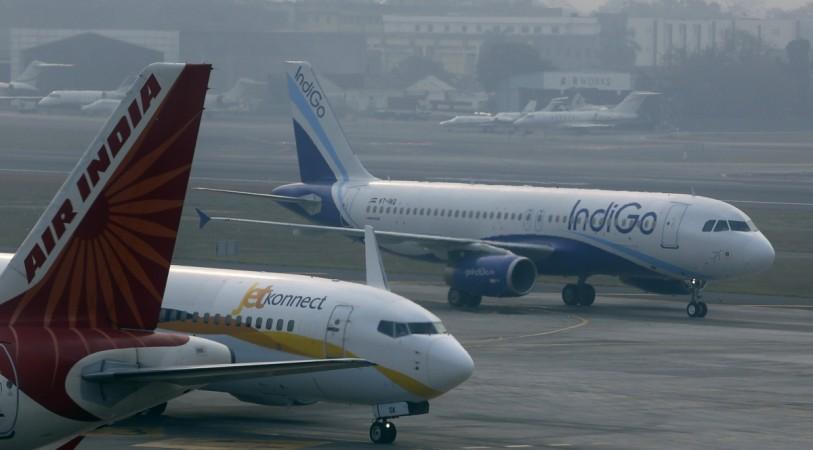
Domestic air traffic grew 23 percent for the 11-month period ended November 2016 in India, but share prices of three listed aviation companies — SpiceJet, Jet Airways and IndiGo-owner Interglobe Aviation — dropped in the range of 24 to 50 percent in calendar year 2016.
Read: Domestic air traffic: IndiGo, SpiceJet, Jet, Air India show divergent trends in November
SpiceJet shares fell 23.9 percent (from Rs 75 to Rs 57); Jet Airways plunged 50 percent (from Rs 702 to Rs 347) and Interglobe Aviation saw its share price dip 33.4 percent (from Rs 1234 to Rs 821).
More bad news is in store for carriers, according to a forecast by aviation think-tank, the Centre for Asia Pacific Aviation (CAPA).
"CAPA estimates that India's airlines reported a combined profit of $122 million in FY2016, the first black ink in a decade. But this era of industry profitability is likely to be short-lived. Traffic growth is being stimulated above its underlying demand as a result of excess capacity and competitive fares," it said, citing parts of its India Aviation Outlook Report FY2017/18.
"The downward pressure on yields, combined with cost creep, is expected to push the consolidated industry result back into the red for the 12 months ending 31-Mar-2017," it added.
Indian domestic carriers comprising the above three companies and others (Air India, GoAir, Vistara, AirAsia India and Air Costa) flew 903 lakh (90 million) passengers between January and November this year, as against 734 (73.4 million) in the corresponding period last year, according to India's civil aviation regulator, DGCA.
The industry is expected to end the current fiscal with 100 million passengers and reach 130 million in 2017-18.
IndiGo is the leader in terms of passengers carried, with a market share of about 40 percent; other major players include Jet Airways, Air India and GoAir.
Almost of them benefitted from low crude oil prices during the year; fuel accounts for about 30-35 percent of operating costs for carriers.
Bleak outlook for FY2017-18
CAPA has projected a mixed outlook for India's civil aviation market, currently the fastest-growing in the world.
The companies are expected to end the current fiscal with 100 million passengers and reach 130 million in 2017-18.
"After a strong FY2016, traffic growth has accelerated further in FY2017, with India likely to overtake Japan this year to become the world's third largest domestic market behind the USA and China," the CAPA said, citing India Aviation Outlook Report FY2017/18 that will be formally released in February next year.
Highlights of the CAPA Report
The next financial year is expected to be the third consecutive year of domestic growth above 20 percent. Growth could be as high as high as 25 percent but may be tempered by 3-5 percentage points because of the impact of demonetisation.
The introduction of the GST next year may possibly also have a short-term negative impact on economic growth for a couple of years until more positive results emerge.
Based on aircraft deliveries, competitive dynamics and the positive outlook for the economy, domestic growth at 20% or higher could continue for up to a further two years.
With LCCs taking delivery of the clear majority of narrow body aircraft coming into the market (an estimated 50 out of 65 inductions), their share of the domestic market is expected to rise from around 65 percent today to reach 75-80 percent within two years.
Full service airline market share could fall to 20-25 percent within two years.
International traffic is expected to expand at 10-12 percent in FY2017 and FY2018, but bilateral restrictions preclude achieving true potential. Several Gulf and Asian carriers are seeking additional entitlements to the tune of up to 150,000 weekly seats.
The government's decision to remove the five-year qualification requirement for domestic airlines to be permitted to operate international services and to retain only the 20-aircraft threshold, may push Vistara and AirAsia India to expand on domestic routes faster than planned. Vistara could bring forward deliveries to reach 20 aircraft by Mar-2018.
CAPA estimates that India's airlines reported a combined profit of USD122 million in FY2016, the first black ink in a decade. But this era of industry profitability is likely to be short-lived. Traffic growth is being stimulated above its underlying demand as a result of excess capacity and competitive fares. The downward pressure on yields, combined with cost creep, is expected to push the consolidated industry result back into the red for the 12 months ending 31-Mar-2017.
IndiGo, Jet Airways, SpiceJet, GoAir and Air India Express are all expected to remain profitable, but at levels lower than in FY2016. Jet Airways will be the only profitable full service carrier in FY2017. While losses are projected to increase at Air India, AirAsia India and Vistara. At a total industry level losses could reach $250-300 million.
With expected cost creep of 10%, a 5-7 percent decline in yields, oil at $55-60 per barrel and an exchange rate of USD1=INR73-75, industry losses could widen further to $380-450 million in FY2018, although most LCCs are expected to remain profitable. Yields could potentially decline further than assumed given the capacity induction planned.

















